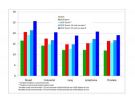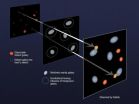(Press-News.org) GALVESTON, Texas — When most people in the developed world think of measles, what comes to mind is only a dim memory of a vaccination at a pediatrician's office. But while childhood vaccination has virtually eliminated measles from North America and much of Europe, researchers remain interested in the virus.
This fascination persists partly because improving the measles vaccine could help eliminate the more than 10 million measles infections and 150,000 measles-caused deaths that still occur worldwide. But it also has another source: Scientists believe that modified measles viruses can be "re-targeted" to attack only tumor cells, and thus transformed into a powerful new therapy for cancer.
Now, a new discovery about the process by which measles invades cells has brought the dream of transforming the virus into a weapon against cancer one step closer to reality. A research team including scientists from the University of Texas Medical Branch at Galveston and the Mayo Clinic in Rochester, Minn. have produced a detailed picture of the intricate molecular mechanism that measles virus uses to attach to and enter the cells it infects.
The key players are two proteins that form the spherical envelope surrounding the genetic material of the measles virus. One is an attachment protein that binds to receptor molecules on the outer membrane of a host cell, and the other is a fusion protein that merges the viral envelope with the cell membrane, enabling the virus to infect the cell. The study, published in the recent issue of Nature Structural Biology & Molecular Biology demonstrated that the intrinsic flexibility of the attachment protein is a necessary condition to initiate the cell fusion process.
"The overall goal of our Mayo Clinic collaborator, Roberto Cattaneo, is to redirect the measles virus to attack specific cancer cells, and to accomplish that he and his group need to know as much as they can about the mechanisms of measles infection," said UTMB professor Werner Braun, an author of the study. "We have a long-standing collaboration with his group, using our theoretical predictions and computational methods to help them better target their experimental work."
UTMB Health research scientist Numan Oezguen used computer-based molecular modeling to predict interaction sites and suggested specific mutations that would alter the interaction and mobility of the attachment protein heads. Results of these experiments performed by the Mayo Clinic team — led by Cattaneo — showed that cell entry of the measles virus depends on a twisting motion of the attachment protein's heads.
To produce an accurate portrait of the dynamic mechanism the Mayo Clinic group created measles viruses with mutations affecting the mobility of their attachment protein heads, and then tested the mutated viruses to determine each type's ability to infect cells. "What Dr. Cattaneo's experiments showed was that the motion of these two parts of the attachment protein has a dramatic effect on infectivity," Braun said. "In a simplified sense, we think this works like a lever — if the cell receptors pull on the attachment protein properly, they generate this type of motion, and this triggers the fusion protein and leads to infectivity."
INFORMATION:
Other authors of the paper include Cattaneo, Chanakha Navaratnarajah, Levi Rupp, Leah Kay and Vincent Leonard of the Mayo Clinic. The National Institutes of Health and the Mayo Clinic Cancer Center supported this research.
ABOUT UTMBHealth: Established in 1891, Texas' first academic health center comprises four health sciences schools, three institutes for advanced study, a research enterprise that includes one of only two national laboratories dedicated to the safe study of infectious threats to human health, and a health system offering a full range of primary and specialized medical services throughout Galveston County and the Texas Gulf Coast region. UTMB Health is a component of the University of Texas System.
The University of Texas Medical Branch at Galveston
Public Affairs Office
301 University Boulevard, Suite 3.102
Galveston, Texas 77555-0144
www.utmb.edu
Measles virus, a weapon against cancer?
2011-01-13
ELSE PRESS RELEASES FROM THIS DATE:
New UCLA-designed microscope records firing of thousands of individual neurons in 3-D
2011-01-13
Some disorders of the brain are obvious — the massive death of brain cells after a stroke, the explosion in the growth of cells that marks a tumor. Other disorders, such as autism, schizophrenia and mental retardation show no physical signs of damage and are believed to be caused by problems in how brain cells communicate with one another.
To understand the root of the problem of these latter diseases, visualizing brain activity is key. But even the best imaging devices available — fMRIs and PET scans — can only give a "coarse" picture of brain activity.
UCLA neuroscientists ...
BRNI identifies new therapies for prevention and treatment of Alzheimer's disease
2011-01-13
Morgantown, WV, January 11, 2011 – A Blanchette Rockefeller Neurosciences Institute (BRNI) study published today in the Journal of Neuroscience reveals underlying causes for the degeneration of synapses in Alzheimer's Disease and identifies promising pharmaceutical solutions for the devastating condition that affects more than 5 million people in the United States. The BRNI study is the first to achieve fundamental molecular understanding of how synapses are lost in Alzheimer's Disease before the plaques and tangles develop. At the same time, it is the first study to ...
Projections of cancer care costs in the US: 2010-2020
2011-01-13
The estimated total cost of cancer care in the United States in 2020 is expected to be $158 billion assuming the most recent observed patterns of incidence, survival, and cost remain the same. This represents a 27% increase from 2010 due only to the projected aging and growth of the US population, according to a study published online January 12th in The Journal of the National Cancer Institute. However, the authors also note the cost of cancer care could rise even more quickly under some reasonable assumptions such as a 2% annual increase in costs of the initial and final ...
GUMC researcher says tinnitus is much more than a 'hearing problem'
2011-01-13
Washington, DC – Tinnitus appears to be produced by an unfortunate confluence of structural and functional changes in the brain, say neuroscientists at Georgetown University Medical Center (GUMC).
The phantom ringing sounds heard by about 40 million people in the U.S. today are caused by brains that try, but fail to protect their human hosts against overwhelming auditory stimuli, the researchers say in the January 13th issue of Neuron. They add that the same process may be responsible for chronic pain and other perceptual disorders.
The researchers say that the absence ...
Cancer costs projected to reach at least $158 billion in 2020
2011-01-13
Based on growth and aging of the U.S. population, medical expenditures for cancer in the year 2020 are projected to reach at least $158 billion (in 2010 dollars) – an increase of 27 percent over 2010, according to a National Institutes of Health analysis. If newly developed tools for cancer diagnosis, treatment, and follow-up continue to be more expensive, medical expenditures for cancer could reach as high as $207 billion, said the researchers from the National Cancer Institute (NCI), part of the NIH. The analysis appears online, Jan. 12, 2011, in the Journal of the National ...
New measure trumps HDL levels in protecting against heart disease
2011-01-13
(PHILADELPHIA) –The discovery that high levels of high-density lipoprotein (HDL) cholesterol (the "good cholesterol") is associated with reduced risk of cardiovascular disease has fostered intensive research to modify HDL levels for therapeutic gain. However, recent findings have called into question the notion that pharmacologic increases in HDL cholesterol levels are necessarily beneficial to patients. Now, a new study from researchers at the University of Pennsylvania School of Medicine shows that a different metric, a measure of HDL function called cholesterol efflux ...
New insight into neuronal survival after brain injury
2011-01-13
A new study identifies a molecule that is a critical regulator of neuron survival after ischemic brain injury. The research, published by Cell Press in the January 13 issue of the journal Neuron, may lead to new therapies that reduce damage after a stroke or other injuries that involve an interruption in blood supply to the brain.
Ischemic brain injury is damage caused by a restriction in blood supply. Neuronal death after an interruption in the supply of oxygen and glucose involves a complex cascade of pathological events and, although previous research has identified ...
Rebooting the brain helps stop the ring of tinnitus in rats
2011-01-13
NIH-funded researchers were able to eliminate tinnitus in a group of rats by stimulating a nerve in the neck while simultaneously playing a variety of sound tones over an extended period of time, says a study published today in the advance online publication of the journal Nature. The hallmark of tinnitus is often a persistent ringing in the ears that is annoying for some, debilitating for others, and currently incurable. Similar to pressing a reset button in the brain, this new therapy was found to help retrain the part of the brain that interprets sound so that errant ...
In deep galaxy surveys, astronomers get a boost -- from gravity
2011-01-13
SEATTLE – Astronomers who survey galaxies in the distant universe are getting some unexpected help from gravity, according to a new study.
In a presentation at the American Astronomical Society meeting this week and a related paper in the current issue of the journal Nature, researchers say that as many as 20 percent of the most distant galaxies currently detected appear brighter than they actually are, because of an effect called "strong gravitational lensing."
The discovery could change astronomers' notions of how galaxies formed in the early universe.
Haojing Yan, ...
Cracking a tooth
2011-01-13
Teeth and bone are important and complex structures in humans and other animals, but little is actually known about their chemical structure at the atomic scale. What exactly gives them their renowned toughness, hardness and strength? How do organisms control the synthesis of these advanced functional composites?
Now, using a highly sophisticated atomic-scale imaging tool on a sea creature's tooth, two Northwestern University researchers have peeled away some of the mystery of organic/inorganic interfaces that are at the heart of tooth and bone structure. They are the ...

